Cobalt Neurotoxicity: Transcriptional Effect of Elevated Cobalt Blood Levels in the Rodent Brain
Abstract
1. Introduction
2. Materials and Methods
2.1. Experimental Animals and Research Design
2.2. Sacrifice of Animals and Tissue Harvest
2.3. Tissue Cobalt Content Measured by ICP-MS
2.4. RNA Extraction
2.4.1. Isolation of RNA
2.4.2. Quality Check of RNA Samples
2.5. RNA Sequencing (RNA-Seq)
2.5.1. Sample Pooling for RNA-Sequencing
2.5.2. RNA-Sequencing Analysis by BGI
2.5.3. Gene Ontology (GO) and KEGG Pathway Enrichment Analysis
2.6. Quantitative Real-Time Polymerase Chain Reaction (RT-qPCR)
2.7. Statistics
3. Results
3.1. Cobalt Accumulates in Organs and in Different Brain Structures
3.2. The Transcriptional Response to the Cobalt Doses Selected Is Non-Proportional
3.3. Global Transcriptional Response in the Pref. Cortex and Hippocampus
4. Discussion
4.1. Metal Distribution Pattern Is Consistent with Previous Research and Cobalt Accumulates Significantly in the Brain
4.2. The Low Range Cobalt Dosage Used Does Not Lead to a Dose-Response
4.3. Overall Transcriptional Effects of Cobalt and the Choroid Plexus as a Target of Cobalt Toxicity
5. Conclusions
Supplementary Materials
Author Contributions
Funding
Institutional Review Board Statement
Informed Consent Statement
Data Availability Statement
Acknowledgments
Conflicts of Interest
References
- Kovochich, M.; Finley, B.L.; Novick, R.; Monnot, A.D.; Donovan, E.; Unice, K.M.; Fung, E.S.; Fung, D.; Paustenbach, D.J. Understanding outcomes and toxicological aspects of second generation metal-on-metal hip implants: A state-of-the-art review. Crit. Rev. Toxicol. 2018, 48, 853–901. [Google Scholar] [CrossRef] [PubMed]
- Langton, D.J.; Jameson, S.S.; Joyce, T.J.; Hallab, N.J.; Natu, S.; Nargol, A.V.F. Early failure of metal-on-metal bearings in hip resurfacing and large-diameter total hip replacement. J. Bone Jt. Surg. Br. 2010, 92, 38–46. [Google Scholar] [CrossRef] [PubMed]
- Sidaginamale, R.P.; Joyce, T.J.; Bowsher, J.G.; Lord, J.K.; Avery, P.J.; Natu, S.; Nargol, A.V.F.; Langton, D.J. The clinical implications of metal debris release from the taper junctions and bearing surfaces of metal-on-metal hip arthroplasty. Bone Jt. J. 2016, 98, 925–933. [Google Scholar] [CrossRef] [PubMed]
- Goode, A.E.; Perkins, J.M.; Sandison, A.; Karunakaran, C.; Cheng, H.; Wall, D.; Skinner, J.A.; Hart, A.J.; Porter, A.E.; McComb, D.W.; et al. Chemical speciation of nanoparticles surrounding metal-on-metal hips. Chem. Commun. 2012, 48, 8335. [Google Scholar] [CrossRef] [PubMed][Green Version]
- MDA/2017/018. Medical Device Alert. All Metal-On-Metal (MoM) Hip Replacements: Updated Advice For Follow-Up of Patients. Available online: http://www.mhra.gov.uk/ (accessed on 29 November 2021).
- Epstein, M.; Emri, I.; Hartemann, P.; Hoet, P.; Leitgeb, N.; Martínez Martínez, L.; Proykova, A.; Rizzo, L.; Rodriguez-Farré, E.; Rushton, L.; et al. Final Opinion on the Safety of Metal-on-Metal Joint Replacements with a Particular Focus on Hip Implants. Sci. Comm. Emerg. New. Identified Heal. Risks, no. September, 2014. Available online: https://ec.europa.eu/health/sites/default/files/scientific_committees/emerging/docs/scenihr_o_042.pdf (accessed on 29 November 2021).
- Rizzetti, M.C.; Liberini, P.; Zarattini, G.; Catalani, S.; Pazzaglia, U.; Apostoli, P.; Padovani, A. Loss of sight and sound. Could it be the hip? Lancet 2009, 373, 1052. [Google Scholar] [CrossRef]
- Tower, S.S. Arthroprosthetic Cobaltism: Neurological and Cardiac Manifestations in Two Patients with Metal-on-Metal Arthroplasty: A Case Report. J. Bone Jt. Surg. Am. 2010, 92, 2847–2851. [Google Scholar] [CrossRef]
- Mao, X.; Wong, A.A.; Crawford, R.W. Cobalt toxicity--an emerging clinical problem in patients with metal-on-metal hip prostheses? Med. J. Aust. 2011, 194, 649–651. [Google Scholar] [CrossRef]
- Green, B.; Griffiths, E.; Almond, S. Neuropsychiatric symptoms following metal-on-metal implant failure with cobalt and chromium toxicity. BMC Psychiatry 2017, 17, 33. [Google Scholar] [CrossRef]
- Catalani, S.; Rizzetti, M.C.; Padovani, A.; Apostoli, P. Neurotoxicity of cobalt. Hum. Exp. Toxicol. 2012, 31, 421–437. [Google Scholar] [CrossRef]
- Machado, C.; Appelbe, A.; Wood, R. Arthroprosthetic Cobaltism and Cardiomyopathy. Hear. Lung. Circ. 2012, 21, 759–760. [Google Scholar] [CrossRef]
- Paustenbach, D.J.; Tvermoes, B.E.; Unice, K.M.; Finley, B.L.; Kerger, B.D. A review of the health hazards posed by cobalt. Crit. Rev. Toxicol. 2013, 43, 316–362. [Google Scholar] [CrossRef] [PubMed]
- Ho, J.H.; Leikin, J.B.; Dargan, P.I.; Archer, J.R.; Wood, D.M.; Brent, J. Metal-on-Metal Hip Joint Prostheses: A Retrospective Case Series Investigating the Association of Systemic Toxicity with Serum Cobalt and Chromium Concentrations. J. Med. Toxicol. 2017, 13, 321–328. [Google Scholar] [CrossRef] [PubMed]
- Karovic, O.; Tonazzini, I.; Rebola, N.; Edström, E.; Lövdahl, C.; Fredholm, B.B.; Dare, E. Toxic effects of cobalt in primary cultures of mouse astrocytes. Similarities with hypoxia and role of HIF-1α. Biochem. Pharmacol. 2007, 73, 694–708. [Google Scholar] [CrossRef] [PubMed]
- Wang, P.; Li, L.; Zhang, Z.; Kan, Q.; Chen, S.; Gao, F. Time-dependent homeostasis between glucose uptake and consumption in astrocytes exposed to CoCl2 treatment. Mol. Med. Rep. 2016, 13, 2909–2917. [Google Scholar] [CrossRef] [PubMed]
- Gómez-Arnaiz, S.; Tate, R.J.; Grant, M.H. Cytotoxicity of cobalt chloride in brain cell lines-a comparison between astrocytoma and neuroblastoma cells. Toxicol. Vitr. 2020, 68, 104958. [Google Scholar] [CrossRef] [PubMed]
- Li, P.; Ding, D.; Salvi, R.; Roth, J.A. Cobalt-Induced Ototoxicity in Rat Postnatal Cochlear Organotypic Cultures. Neurotox. Res. 2015, 28, 209–221. [Google Scholar] [CrossRef]
- Kikuchi, S.; Ninomiya, T.; Kohno, T.; Kojima, T.; Tatsumi, H. Cobalt inhibits motility of axonal mitochondria and induces axonal degeneration in cultured dorsal root ganglion cells of rat. Cell Biol. Toxicol. 2018, 34, 93–107. [Google Scholar] [CrossRef]
- Chimeh, U.; Zimmerman, M.A.; Gilyazova, N.; Li, P.A. B355252, a novel small molecule, confers neuroprotection against cobalt chloride toxicity in mouse hippocampal cells through altering mitochondrial dynamics and limiting autophagy induction. Int. J. Med. Sci. 2018, 15, 1384–1396. [Google Scholar] [CrossRef]
- Naves, T.; Jawhari, S.; Jauberteau, M.O.; Ratinaud, M.H.; Verdier, M. Autophagy takes place in mutated p53 neuroblastoma cells in response to hypoxia mimetic CoCl2. Biochem. Pharmacol. 2013, 85, 1153–1161. [Google Scholar] [CrossRef]
- Fung, F.K.; Law, B.Y.; Lo, A.C. Lutein Attenuates Both Apoptosis and Autophagy upon Cobalt (II) Chloride-Induced Hypoxia in Rat Műller Cells. PLoS ONE 2016, 11, e0167828. [Google Scholar] [CrossRef]
- Mou, Y.H.; Yang, J.Y.; Cui, N.; Wang, J.M.; Hou, Y.; Song, S.; Wu, C.F. Effects of cobalt chloride on nitric oxide and cytokines/chemokines production in microglia. Int. Immunopharmacol. 2012, 13, 120–125. [Google Scholar] [CrossRef] [PubMed]
- McMullen, P.D.; Pendse, S.N.; Black, M.B.; Mansouri, K.; Haider, S.; Andersen, M.E.; Clewell, R.A. Addressing systematic inconsistencies between in vitro and in vivo transcriptomic mode of action signatures. Toxicol. Vitr. 2019, 58, 1–12. [Google Scholar] [CrossRef] [PubMed]
- Joseph, P. Transcriptomics in toxicology. Food Chem. Toxicol. 2017, 109, 650–662. [Google Scholar] [CrossRef] [PubMed]
- Garoui, E.; Amara, I.B.; Driss, D.; Elwej, A.; Chaabouni, S.E.; Boudawara, T.; Zeghal, N. Effects of Cobalt on Membrane ATPases, Oxidant, and Antioxidant Values in the Cerebrum and Cerebellum of Suckling Rats. Biol. Trace Elem. Res. 2013, 154, 387–395. [Google Scholar] [CrossRef]
- Caltana, L.; Merelli, A.; Lazarowski, A.; Brusco, A. Neuronal and Glial Alterations Due to Focal Cortical Hypoxia Induced by Direct Cobalt Chloride (CoCl2) Brain Injection. Neurotox. Res. 2009, 15, 348–358. [Google Scholar] [CrossRef]
- Kajiwara, K.; Sunaga, K.; Tsuda, T.; Sugaya, A.; Sugaya, E.; Kimura, M. Peony root extract upregulates transthyretin and phosphoglycerate mutase in mouse cobalt focus seizure. Biochem. Biophys. Res. Commun. 2008, 371, 375–379. [Google Scholar] [CrossRef]
- Denisov, V.; Strong, W.; Walder, M.; Gingrich, J.; Wintz, H. Development and Validation of RQI: An RNA Quality Indicator for the Experion Automated Electrophoresis System. Bio-Rad Bull 2008, 5761. Available online: http://www.gene-quantification.org/Bio-Rad-bulletin-5761.pdf (accessed on 29 November 2021).
- Shannon, P.; Markiel, A.; Ozier, O.; Baliga, N.S.; Wang, J.T.; Ramage, D.; Amin, N.; Schwikowski, B.; Ideker, T. Cytoscape: A software environment for integrated models of biomolecular interaction networks. Genome Res. 2003, 13, 2498–2504. [Google Scholar] [CrossRef]
- Bindea, G.; Mlecnik, B.; Hackl, H.; Charoentong, P.; Tosolini, M.; Kirilovsky, A.; Fridman, W.-H.; Pagès, F.; Trajanoski, Z.; Galon, J. ClueGO: A Cytoscape plug-in to decipher functionally grouped gene ontology and pathway annotation networks. Bioinformatics 2009, 25, 1091–1093. [Google Scholar] [CrossRef]
- Szklarczyk, D.; Gable, A.L.; Lyon, D.; Junge, A.; Wyder, S.; Huerta-Cepas, J.; Simonovic, M.; Doncheva, N.T.; Morris, J.H.; Bork, P.; et al. STRING v11: Protein-protein association networks with increased coverage, supporting functional discovery in genome-wide experimental datasets. Nucleic Acids Res. 2019, 47, D607–D613. [Google Scholar] [CrossRef]
- Bustin, S.A.; Benes, V.; Garson, J.A.; Hellemans, J.; Huggett, J.; Kubista, M.; Mueller, R.; Nolan, T.; Pfaffl, M.W.; Shipley, G.L. The MIQE Guidelines: Minimum Information for Publication of Quantitative Real-Time PCR Experiments. Clin. Chem. 2009, 55, 611–622. [Google Scholar] [CrossRef]
- Schmittgen, T.D.; Livak, K.J. Analyzing real-time PCR data by the comparative CT method. Nat. Protoc. 2008, 3, 1101–1108. [Google Scholar] [CrossRef] [PubMed]
- Xie, F.; Xiao, P.; Chen, D.; Xu, L.; Zhang, B. miRDeepFinder: A miRNA analysis tool for deep sequencing of plant small RNAs. Plant Mol. Biol. 2012, 80, 75–84. [Google Scholar] [CrossRef] [PubMed]
- Sidaginamale, R.P.; Joyce, T.J.; Lord, J.K.; Jefferson, R.; Blain, P.G.; Nargol, A.V.F.; Langton, D.J. Blood metal ion testing is an effective screening tool to identify poorly performing metal-on-metal bearing surfaces. Bone Jt. Res. 2013, 2, 84–95. [Google Scholar] [CrossRef] [PubMed]
- Zywiel, M.G.; Brandt, J.M.; Overgaard, C.B.; Cheung, A.C.; Turgeon, T.R.; Syed, K.A. Fatal cardiomyopathy after revision total hip replacement for fracture of a ceramic liner. Bone Jt. J. 2013, 95, 31–37. [Google Scholar] [CrossRef] [PubMed]
- Lun, M.P.; Johnson, M.B.; Broadbelt, K.G.; Watanabe, M.; Kang, Y.J.; Chau, K.F.; Springel, M.W.; Malesz, A.; Sousa, A.M.M.; Pletikos, M.; et al. Spatially Heterogeneous Choroid Plexus Transcriptomes Encode Positional Identity and Contribute to Regional CSF Production. J. Neurosci. 2015, 35, 4903–4916. [Google Scholar] [CrossRef] [PubMed]
- Mathew, R.S.; Mullan, H.; Blusztajn, J.K.; Lehtinen, M.K. Comment on ‘Multiple repressive mechanisms in the hippocampus during memory formation. ’ Science 2016, 353, 453. [Google Scholar] [CrossRef] [PubMed]
- Sathyanesan, M.; Girgenti, M.J.; Banasr, M.; Stone, K.; Bruce, C.; Guilchicek, E.; Wilczak-Havill, K.; Nairn, A.; Williams, K.; Sass, S.; et al. A molecular characterization of the choroid plexus and stress-induced gene regulation. Transl. Psychiatry 2012, 2, e139. [Google Scholar] [CrossRef]
- Everaert, C.; Luypaert, M.; Maag, J.L.; Cheng, Q.X.; Dinger, M.E.; Hellemans, J.; Mestdagh, P. Benchmarking of RNA-sequencing analysis workflows using whole-transcriptome RT-qPCR expression data. Sci. Rep. 2017, 7, 1559. [Google Scholar] [CrossRef]
- Assefa, A.T.; Vandesompele, J.; Thas, O. On the utility of RNA sample pooling to optimize cost and statistical power in RNA sequencing experiments. BMC Genom. 2020, 21, 312. [Google Scholar] [CrossRef]
- Laovitthayanggoon, S.; Henderson, C.J.; McCluskey, C.; MacDonald, M.; Tate, R.J.; Grant, M.H.; Currie, S. Cobalt Administration Causes Reduced Contractility with Parallel Increases in TRPC6 and TRPM7 Transporter Protein Expression in Adult Rat Hearts. Cardiovasc. Toxicol. 2019, 19, 276–286. [Google Scholar] [CrossRef]
- Afolaranmi, G.A.; Akbar, M.; Brewer, J.; Grant, M.H. Distribution of metal released from cobalt–chromium alloy orthopaedic wear particles implanted into air pouches in mice. J. Biomed. Mater. Res. A 2012, 100, 1529–1538. [Google Scholar] [CrossRef] [PubMed]
- Apostoli, P.; Catalani, S.; Zaghini, A.; Mariotti, A.; Poliani, P.L.; Vielmi, V.; Semeraro, F.; Duse, S.; Porzionato, A.; Macchi, V.; et al. High doses of cobalt induce optic and auditory neuropathy. Exp. Toxicol. Pathol. 2013, 65, 719–727. [Google Scholar] [CrossRef] [PubMed]
- Daniel, J.; Ziaee, H.; Pradhan, C.; Pynsent, P.B.; McMinn, D.J. Renal Clearance of Cobalt in Relation to the Use of Metal-on-Metal Bearings in Hip Arthroplasty. J. Bone Jt. Surg. Am. 2010, 92, 840–845. [Google Scholar] [CrossRef] [PubMed]
- Martin, J.R.; Spencer-Gardner, L.; Camp, C.L.; Stulak, J.M.; Sierra, R.J. Cardiac cobaltism: A rare complication after bilateral metal-on-metal total hip arthroplasty. Arthroplast. Today 2015, 1, 99–102. [Google Scholar] [CrossRef] [PubMed]
- Allen, L.A.; Ambardekar, A.V.; Devaraj, K.M.; Maleszewski, J.J.; Wolfel, E.E. Missing elements of the history. N. Engl. J. Med. 2014, 370, 559–566. [Google Scholar] [CrossRef]
- Wyles, C.C.; Wright, T.C.; Bois, M.C.; Amin, S.; Fayyaz, A.; Jenkins, S.M.; Wyles, S.P.; Day, P.L.; Murray, D.L.; Trousdale, R.T.; et al. Myocardial cobalt levels are elevated in the setting of total hip arthroplasty. J. Bone Jt. Surg. Am. 2017, 99, e118. [Google Scholar] [CrossRef]
- Garcia, F.; Ortega, A.; Domingo, J.L.; Corbella, J. Accumulation of metals in autopsy tissues of subjects living in Tarragona County, Spain. J. Environ. Sci. Heal. Part. A 2001, 36, 1767–1786. [Google Scholar] [CrossRef]
- Ferguson, C.S.; Tyndale, R.F. Cytochrome P450 enzymes in the brain: Emerging evidence of biological significance. Trends Pharmacol. Sci. 2011, 32, 708–714. [Google Scholar] [CrossRef]
- Pikuleva, I.A.; Waterman, M.R. Cytochromes P450: Roles in Diseases. J. Biol. Chem. 2013, 288, 17091–17098. [Google Scholar] [CrossRef]
- Dixit, V.A.; Warwicker, J.; De Visser, S.P. How Do Metal Ions Modulate the Rate-Determining Electron-Transfer Step in Cytochrome P450 Reactions? Chem. A Eur. J. 2020, 26, 15270–15281. [Google Scholar] [CrossRef]
- Honkakoski, P.; Negishi, M. Regulation of cytochrome P450 (CYP) genes by nuclear receptors. Biochem. J. 2000, 347, 321–337. [Google Scholar] [CrossRef] [PubMed]
- Kinoshita, T. Biosynthesis and biology of mammalian GPI-anchored proteins. Open Biol. 2020, 10, 190290. [Google Scholar] [CrossRef] [PubMed]
- Umbsaar, J.; Kerek, E.; Prenner, E.J. Cobalt and nickel affect the fluidity of negatively-charged biomimetic membranes. Chem. Phys. Lipids 2018, 210, 28–37. [Google Scholar] [CrossRef] [PubMed]
- Urban, R.M.; Tomlinson, M.J.; Hall, D.J.; Jacobs, J.J. Accumulation in liver and spleen of metal particles generated at nonbearing surfaces in hip arthroplasty. J. Arthroplast. 2004, 19, 94–101. [Google Scholar] [CrossRef] [PubMed]
- Stankiewicz, A.M.; Goscik, J.; Majewska, A.; Swiergiel, A.H.; Juszczak, G.R. The Effect of Acute and Chronic Social Stress on the Hippocampal Transcriptome in Mice. PLoS ONE 2015, 10, e0142195. [Google Scholar] [CrossRef]
- Cho, J.; Yu, N.K.; Choi, J.H.; Sim, S.E.; Kang, S.J.; Kwak, C.; Lee, S.-W.; Kim, J.-I.; Choi, D.I.; Kim, V.N.; et al. Multiple repressive mechanisms in the hippocampus during memory formation. Science 2015, 350, 82–87. [Google Scholar] [CrossRef]
- Schneider, J.S.; Anderson, D.W.; Sonnenahalli, H.; Vadigepalli, R. Sex-based differences in gene expression in hippocampus following postnatal lead exposure. Toxicol. Appl. Pharmacol. 2011, 256, 179–190. [Google Scholar] [CrossRef]
- Watanabe, T.; Natt, O.; Boretius, S.; Frahm, J.; Michaelis, T. In vivo 3D MRI staining of mouse brain after subcutaneous application of MnCl2. Magn. Reson. Med. 2002, 48, 852–859. [Google Scholar] [CrossRef]
- Sudarshana, D.M.; Nair, G.; Dwyer, J.T.; Dewey, B.; Steele, S.U.; Suto, D.J.; Wu, T.; Berkowitz, B.A.; Koretsky, A.P.; Cortese, I.C.M.; et al. Manganese-enhanced MRI of the brain in healthy volunteers. Am. J. Neuroradiol. 2019, 40, 1309–1316. [Google Scholar] [CrossRef]
- Steuerwald, A.J.; Blaisdell, F.S.; Geraghty, C.M.; Parsons, P.J. Regional Distribution and Accumulation of Lead in Caprine Brain Tissues Following a Long-Term Oral Dosing Regimen. J. Toxicol. Environ. Heal. Part. A 2014, 77, 663–678. [Google Scholar] [CrossRef]
- Manton, W.I.; Kirkpatrick, J.B.; Cook, J.D. Does the choroid plexus really protect the brain from lead? Lancet 1984, 324, 351. [Google Scholar] [CrossRef]
- Takeda, A.; Takefuta, S.; Ijiro, H.; Okada, S.; Oku, N. 109Cd transport in rat brain. Brain Res. Bull. 1999, 49, 453–457. [Google Scholar] [CrossRef]
- Nakamura, M.; Yasutake, A.; Fujimura, M.; Hachiya, N.; Marumoto, M. Effect of methylmercury administration on choroid plexus function in rats. Arch. Toxicol. 2011, 85, 911–918. [Google Scholar] [CrossRef] [PubMed]
- Harrison-Brown, M.; Scholes, C.; Field, C.; McQuilty, R.; Farah, S.B.; Nizam, I.; Kerr, D.; Kohan, L. Limited penetration of cobalt and chromium ions into the cerebrospinal fluid following metal on metal arthroplasty: A cross-sectional analysis. Clin. Toxicol. 2020, 58, 233–240. [Google Scholar] [CrossRef]
- Quintela, T.; Goncalves, I.; Carreto, L.C.; Santos, M.A.S.; Marcelino, H.; Patriarca, F.M.; Santos, C.R.A. Analysis of the Effects of Sex Hormone Background on the Rat Choroid Plexus Transcriptome by cDNA Microarrays. PLoS ONE 2013, 8, e60199. [Google Scholar] [CrossRef]
- Gradinaru, D.; Minn, A.L.; Artur, Y.; Minn, A.; Heydel, J.M. Drug metabolizing enzyme expression in rat choroid plexus: Effects of in vivo xenobiotics treatment. Arch. Toxicol. 2009, 83, 581–586. [Google Scholar] [CrossRef]
- Ghersi-Egea, J.F.; Strazielle, N.; Catala, M.; Silva-Vargas, V.; Doetsch, F.; Engelhardt, B. Molecular anatomy and functions of the choroidal blood-cerebrospinal fluid barrier in health and disease. Acta Neuropathol. 2018, 135, 337–361. [Google Scholar] [CrossRef]
- Zhu, L.; Stein, L.R.; Kim, D.; Ho, K.; Yu, G.Q.; Zhan, L.; Larsson, T.E.; Mucke, L. Klotho controls the brain–immune system interface in the choroid plexus. Proc. Natl. Acad. Sci. USA 2018, 115, E11388–E11396. [Google Scholar] [CrossRef]
- Baruch, K.; Ron-Harel, N.; Gal, H.; Deczkowska, A.; Shifrut, E.; Ndifon, W.; Mirlas-Neisberg, N.; Cardon, M.; Vaknin, I.; Cahalon, L.; et al. CNS-specific immunity at the choroid plexus shifts toward destructive Th2 inflammation in brain aging. Proc. Natl. Acad. Sci. USA 2013, 110, 2264–2269. [Google Scholar] [CrossRef]
- Stock, A.D.; Der, E.; Gelb, S.; Huang, M.; Weidenheim, K.; Ben-Zvi, A.; Putterman, C. Tertiary lymphoid structures in the choroid plexus in neuropsychiatric lupus. JCI Insight 2019, 4, e124203. [Google Scholar] [CrossRef]
- Vincent, C.; Gilabert-Juan, J.; Gibel-Russo, R.; Alvarez-Fischer, D.; Krebs, M.O.; Le Pen, G.; Prochiantz, A.; Di Nardo, A.A. Non-cell-autonomous OTX2 transcription factor regulates anxiety-related behavior in the mouse. Mol. Psychiatry 2021, 26, 1–12. [Google Scholar] [CrossRef]
- Turner, C.A.; Thompson, R.C.; Bunney, W.E.; Schatzberg, A.F.; Barchas, J.D.; Myers, R.M.; Akil, H.; Watson, S.J. Altered choroid plexus gene expression in major depressive disorder. Front. Hum. Neurosci. 2014. 8, 238. [CrossRef]
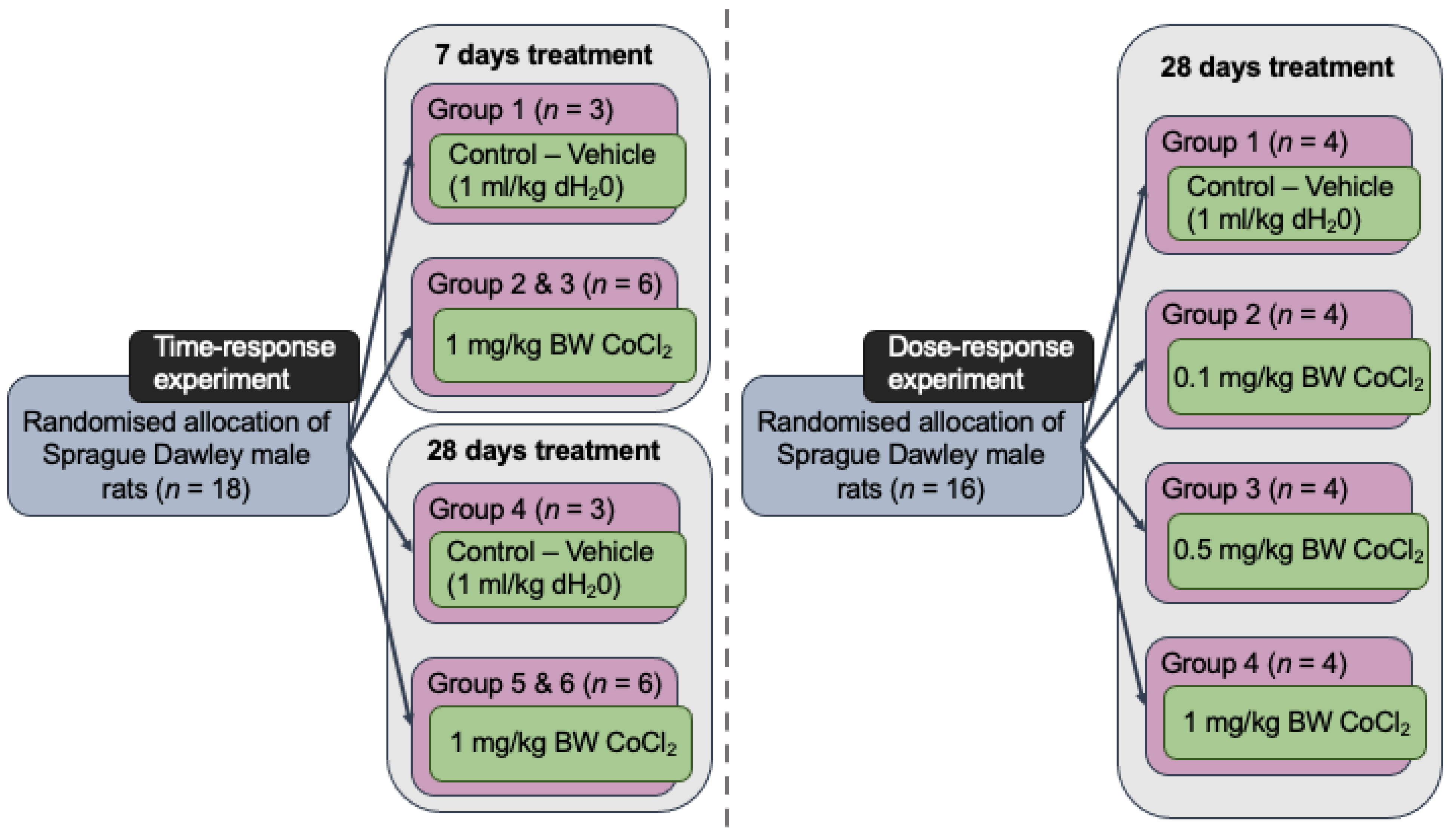
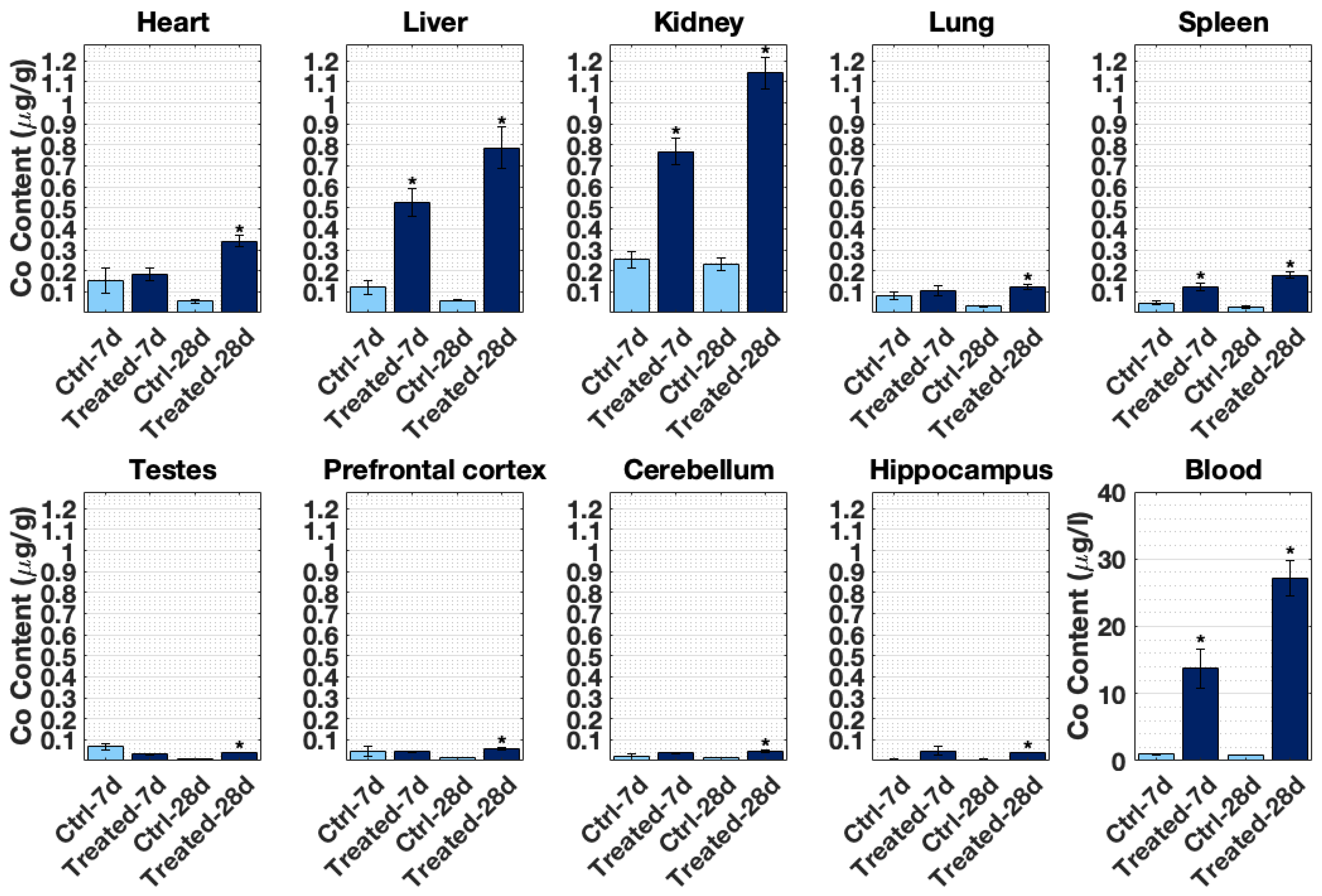
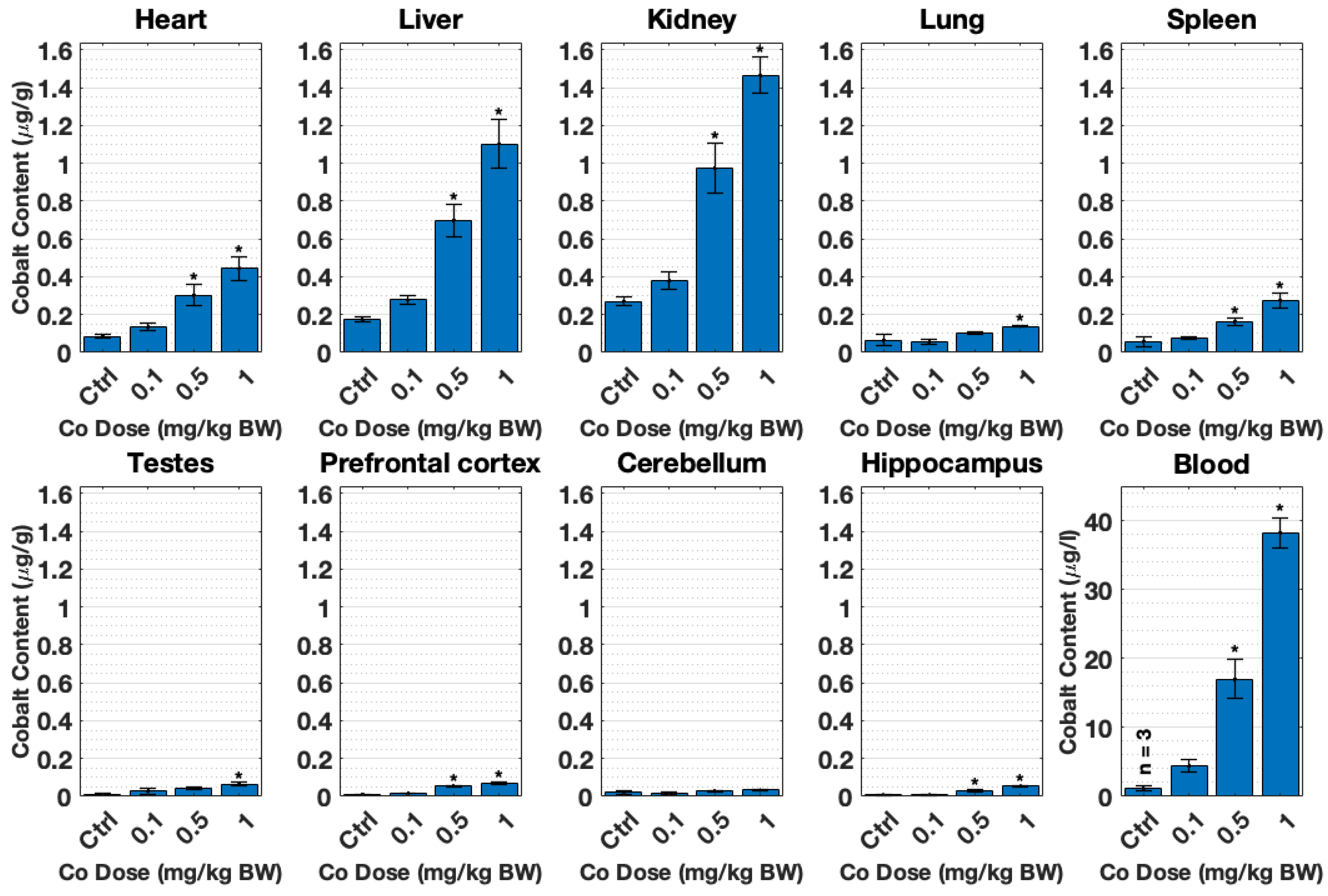
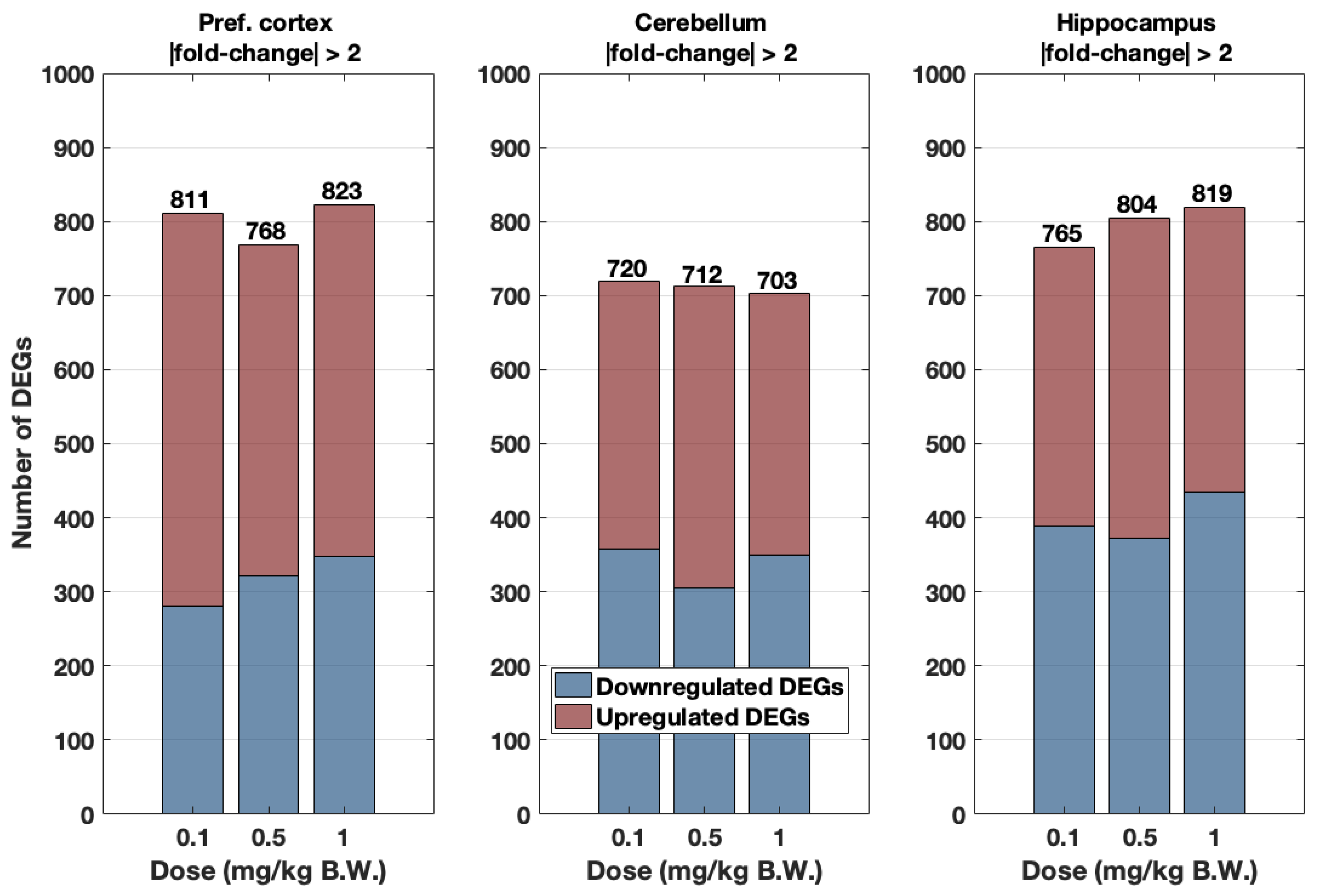
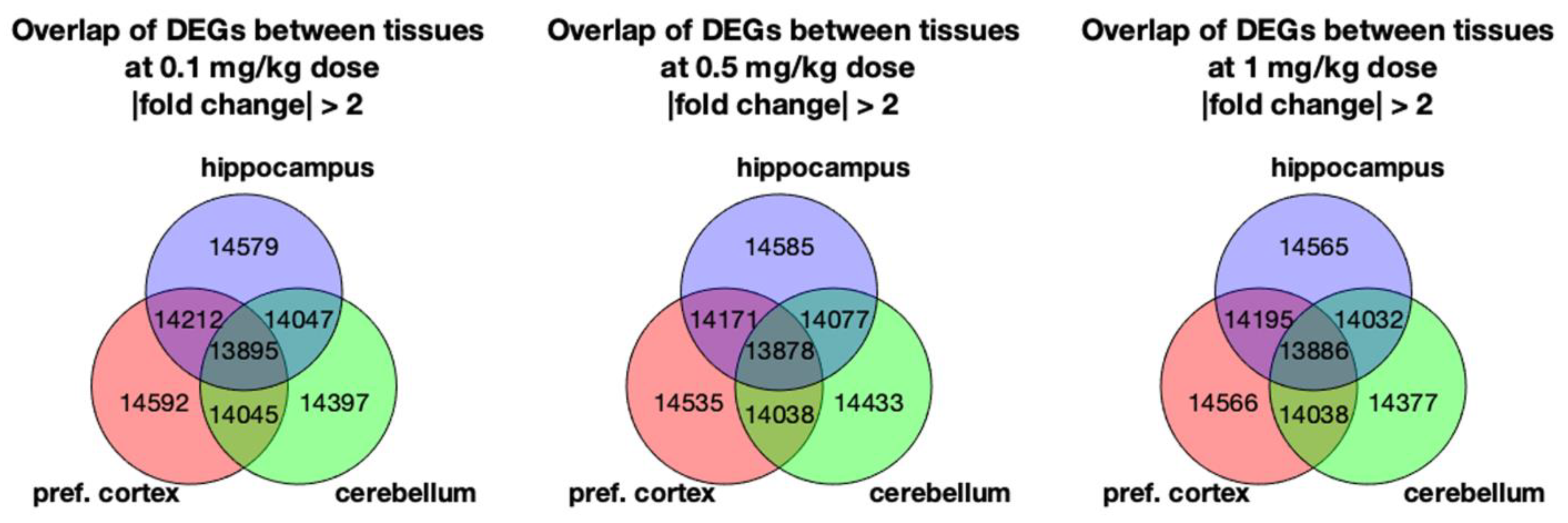
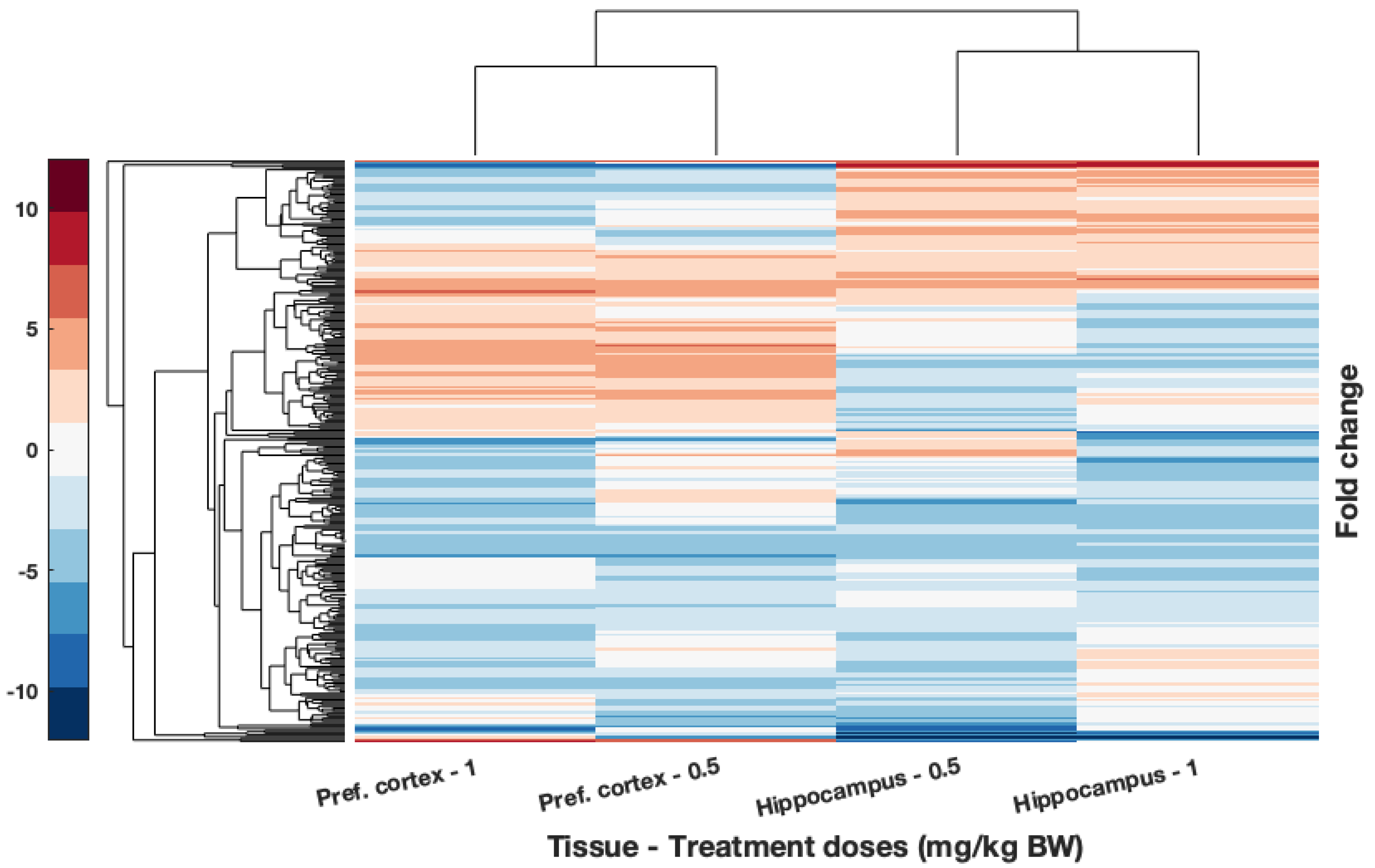
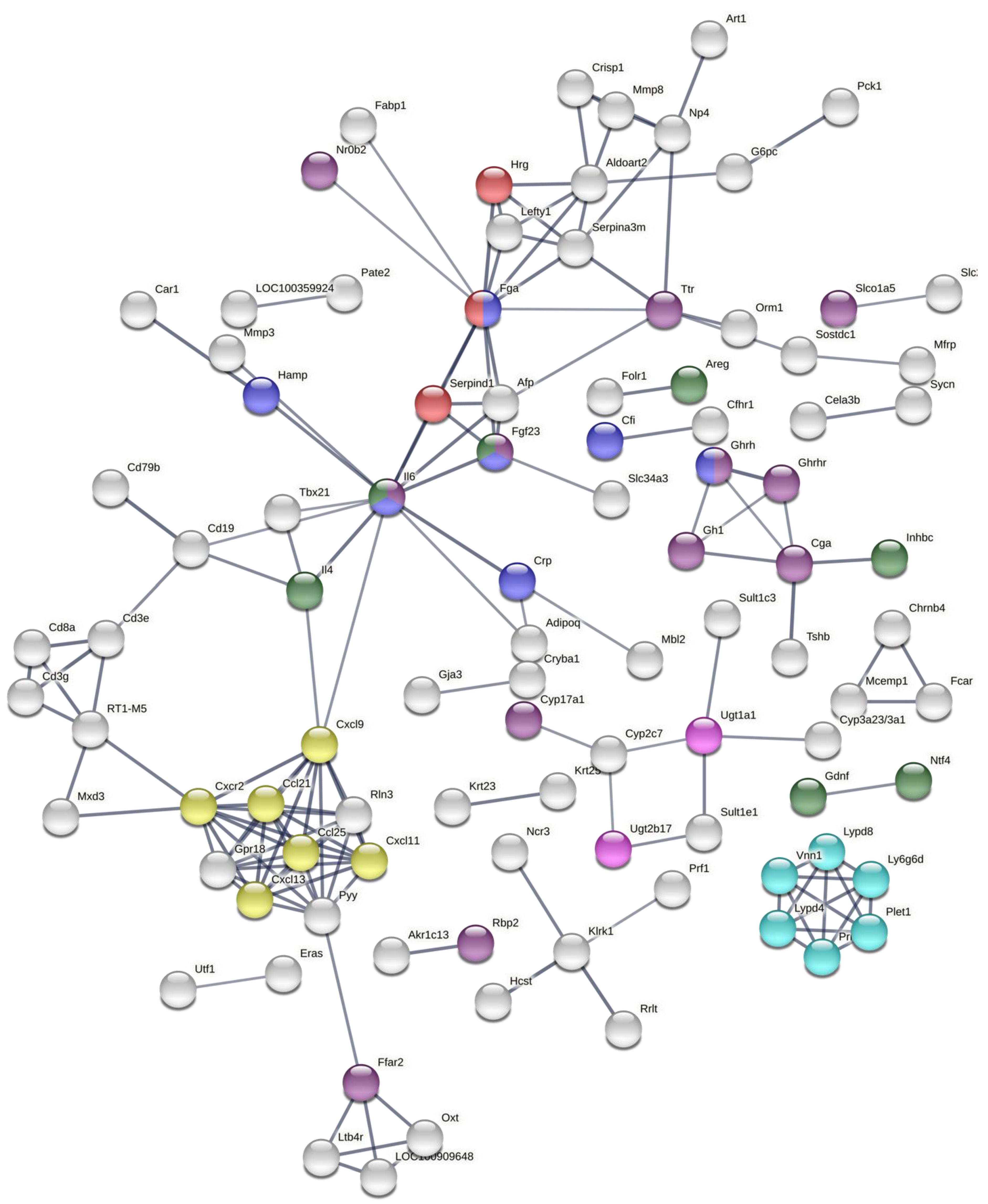
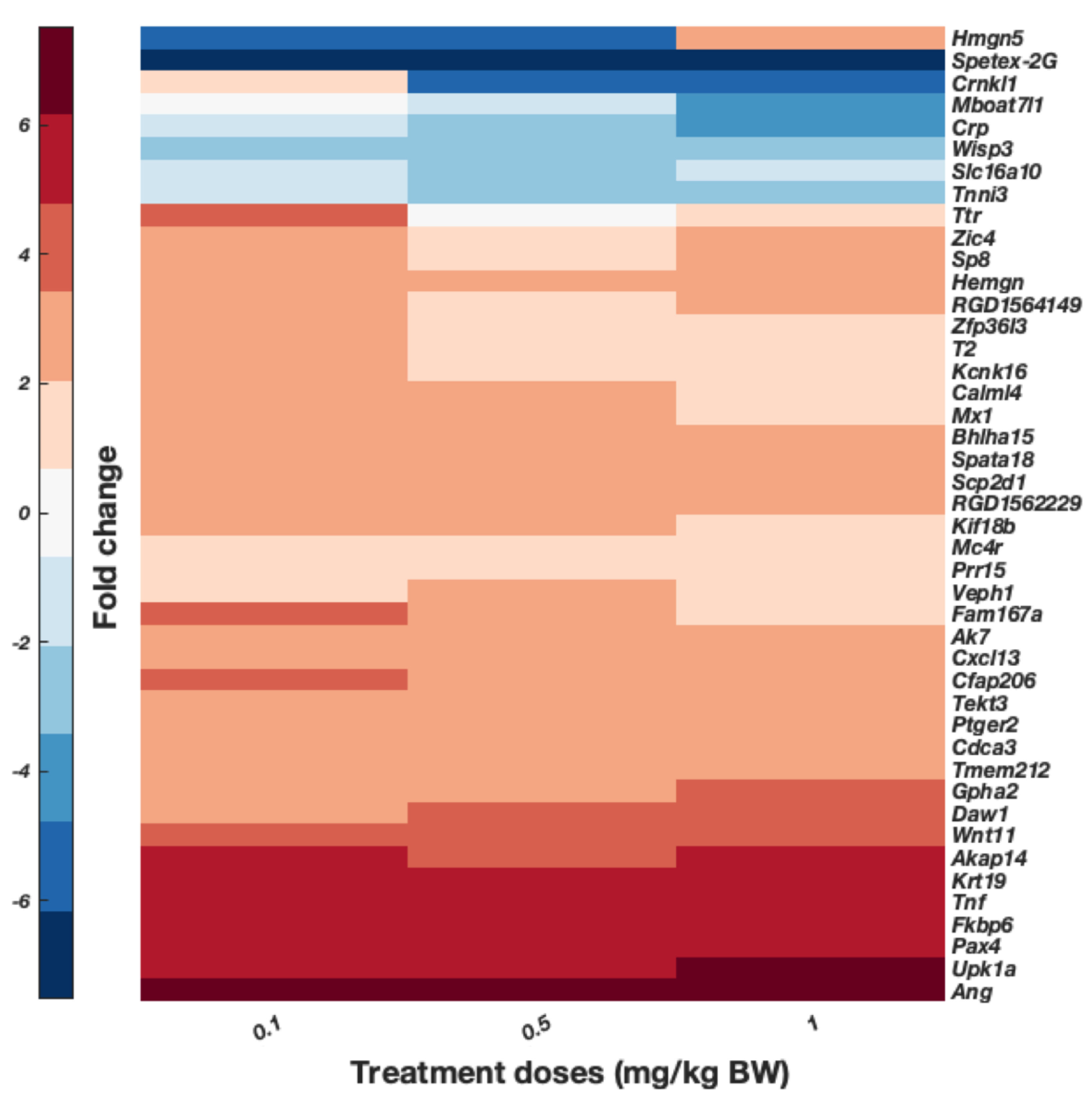

| Gene Ontologies (GO) and GO Terms | Number of Genes with Annotations in the Ontology (%) | Number of Genes Represented in GO Terms (%) |
|---|---|---|
| Biological Process (BP) GO terms (8 April 2016) | 194 (72.12%) | 93 (34.57%) |
| Regulation of hormone levels | Afp, Bco1, Bik, Cga, Cyp11a1, Cyp17a1, Fam3b, Ffar2, Fga, Fgf23, Gh1, Ghrh, Ghrhr, Il6, Nr0b2, Nt5c1b, Pax8, Slc30a8, Slco1a5, Sult1e1 | |
| Response to interleukin-6 | Crp, Fga, Fgf23, Ghrh, Hamp, Il6, Pck1 | |
| T-helper 17 cell lineage commitment | Batf, Il6, Ly9 | |
| Response to vitamin | Cyp11a1, Fgf23, Folr1, Hamp, Orm1, Otc, Sult2a1, Tshb | |
| Response to pH | Acer1, Gh1, Gja3, Kcnk18, Pck1 | |
| Response to interleukin-1 | Ccl21, Ccl25, Cyp11a1, Il6, Mmp3, Pck1, Slc30a8 | |
| Cell chemotaxis | Ccl21, Ccl25, Ccr6, Cxcl13, Cxcl9, Cxcr2, Ffar2, Hrg, Stap1 | |
| Organ formation | Folr1, Foxh1, Gdnf, Ntf4, Pax8 | |
| Cell fate commitment | Batf, Elf5, Gata5, Gsx1, Gsx2, Il6, Ly9, Myl2, Ntf4, Olig3, Sostdc1 | |
| Molecular Function (MF) GO terms (8 April 2016) | 185 (68.77%) | 60 (22.3%) |
| Cytokine receptor binding | Bmp10, Ccl21, Ccl25, Cxcl13, Cxcl9, Gh1, Il6, Inhbc, Ntf4, Stap1 | |
| Heparin binding | Ang2, Comp, Cxcl13, Hrg, Mcpt4, Serpind1, Wisp3 | |
| Growth factor activity | Areg, Bmp10, Fgf23, Gdnf, Il6, Inhbc, Ntf4 | |
| Steroid binding | Comp, Crp, Cyp11a1, Fabp1, Sult1e1, Ugt1a1 | |
| Hormone activity | Bmp10, Cga, Gh1, Ghrh, Gpha2, Hamp, Inhbc, Pyy, Rln3, Tshb | |
| KEGG terms (14 June 2016) | 97 (36.06%) | 29 (10.78%) |
| Steroid hormone biosynthesis | Cyp11a1, Cyp17a1, Cyp2c7, Cyp3a23/3a1, Sult1e1, Ugt1a1, Ugt2b17 | |
| Hematopoietic cell lineage | Cd19, Cd3g, Cd8a, Fcer2, Il1r2, Il6 | |
| Cellular Component terms (8 April 2016) | 216 (80.3%) | 18 (6.69%) |
| External side of plasma membrane | Cd19, Cd8a, Cxcl9, Fcer2, Fga, Folr1, Hyal5, Il6, Itgad, Trpm8 | |
| Studies | Time-Response Study | Dose-Response Study | [45] | [47] | [48] | [49] | |
|---|---|---|---|---|---|---|---|
| Study outline | CoCl2 | CoCl2 | CoCl2 | MoP Patients | |||
| SD rats | SD rats | rabbits | MoM patient | MoM patient | |||
| 28 days | 28 days | 18 days | |||||
| 1 mg/kg BW | 1 mg/kg BW | 1354 µg/mL | |||||
| i.p. | i.p. | Intravenous infusion | |||||
| Tissues | n = 3 (C) and 6 (T) | n = 4 (C) and 4 (T) | n = 2 (C) and 4 (T) | case report | case report | n = 73 (C), 75 (THA) | |
| WB or serum (µg/L) | Cobalt exposed | 27.15 ± 2.70 * (WB) | 38.24 ± 2.14 * (WB) | 420.9 ± 154.5 (WB) | 192 (serum) | 287.6 (serum) | Unknown |
| Controls/unexposed | 0.87 ± 0.00 | 1.17 ± 0.32 | 11.7 ± 2.7 | <1 | |||
| Brain (µg/g) | Cobalt exposed | 0.06 ± 0.00 * (pref. cortex) | 0.07 ± 0.01 * (pref. cortex) | 0.2 ± 0.2 | Unknown | ||
| Controls | 0.02 ± 0.00 | 0.01 ± 0.00 | 0.06 ± 0.04 | <0.025 | |||
| Heart (µg/g) | Cobalt exposed | 0.34 ± 0.03 * | 0.44 ± 0.06 * | 0.7 ± 0.5 | 4.75 | 8.32 | 0.12 (avg.); range: 0.006–6.299 |
| Controls/unexposed | 0.06 ± 0.01 | 0.09 ± 0.01 | 0.07 ± 0.1 | 0.06 | |||
Publisher’s Note: MDPI stays neutral with regard to jurisdictional claims in published maps and institutional affiliations. |
© 2022 by the authors. Licensee MDPI, Basel, Switzerland. This article is an open access article distributed under the terms and conditions of the Creative Commons Attribution (CC BY) license (https://creativecommons.org/licenses/by/4.0/).
Share and Cite
Gómez-Arnaiz, S.; Tate, R.J.; Grant, M.H. Cobalt Neurotoxicity: Transcriptional Effect of Elevated Cobalt Blood Levels in the Rodent Brain. Toxics 2022, 10, 59. https://doi.org/10.3390/toxics10020059
Gómez-Arnaiz S, Tate RJ, Grant MH. Cobalt Neurotoxicity: Transcriptional Effect of Elevated Cobalt Blood Levels in the Rodent Brain. Toxics. 2022; 10(2):59. https://doi.org/10.3390/toxics10020059
Chicago/Turabian StyleGómez-Arnaiz, Sara, Rothwelle J. Tate, and Mary Helen Grant. 2022. "Cobalt Neurotoxicity: Transcriptional Effect of Elevated Cobalt Blood Levels in the Rodent Brain" Toxics 10, no. 2: 59. https://doi.org/10.3390/toxics10020059
APA StyleGómez-Arnaiz, S., Tate, R. J., & Grant, M. H. (2022). Cobalt Neurotoxicity: Transcriptional Effect of Elevated Cobalt Blood Levels in the Rodent Brain. Toxics, 10(2), 59. https://doi.org/10.3390/toxics10020059






